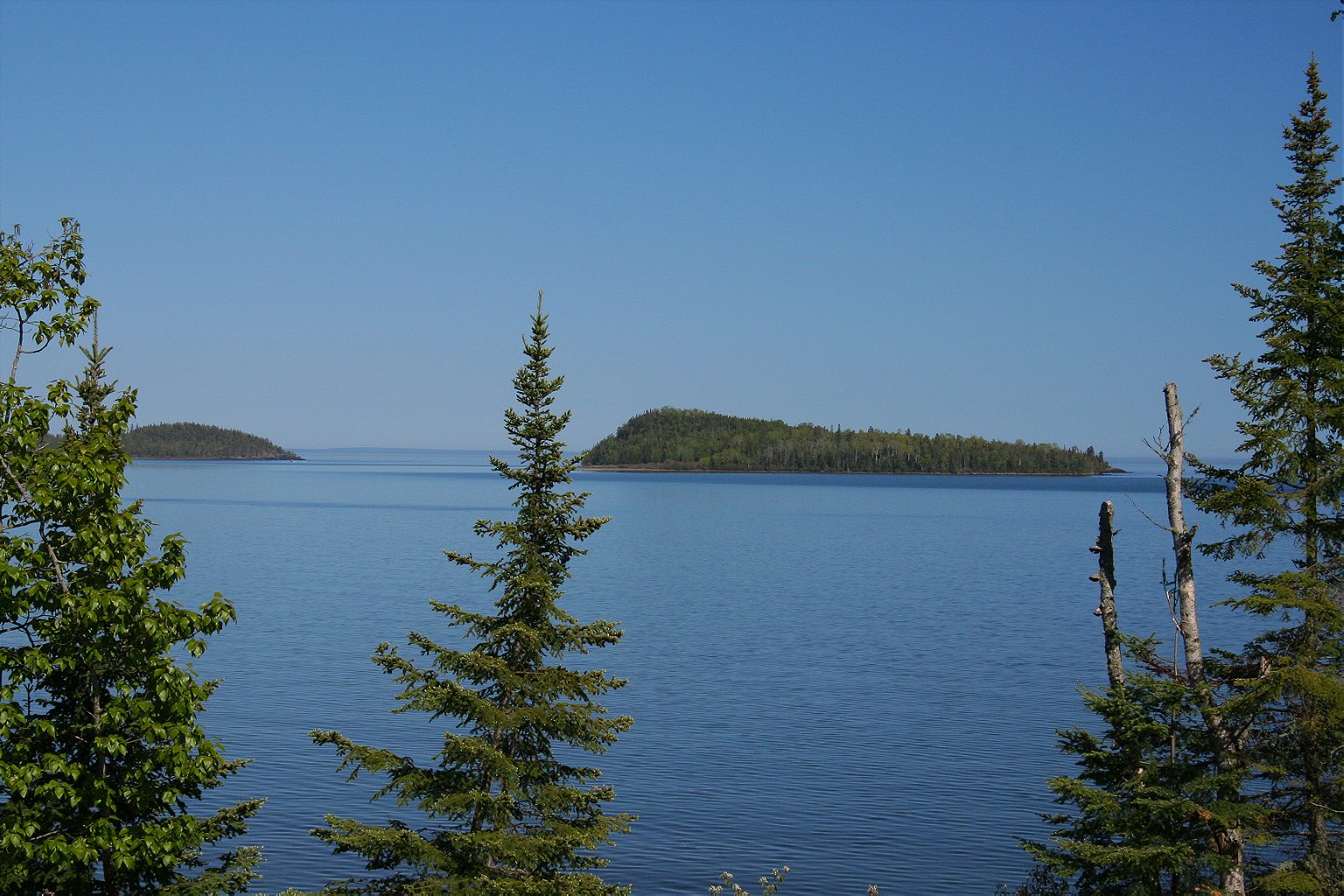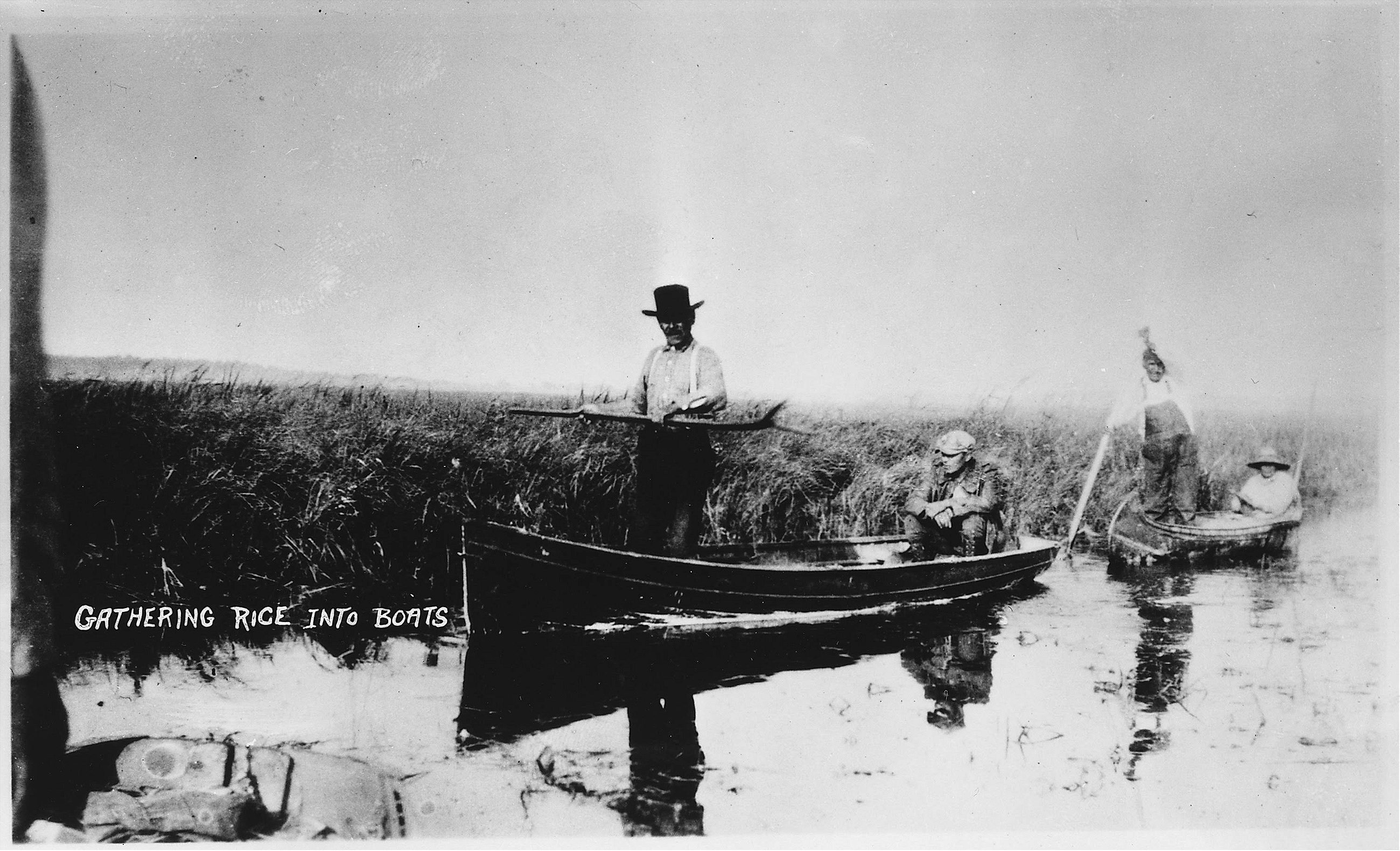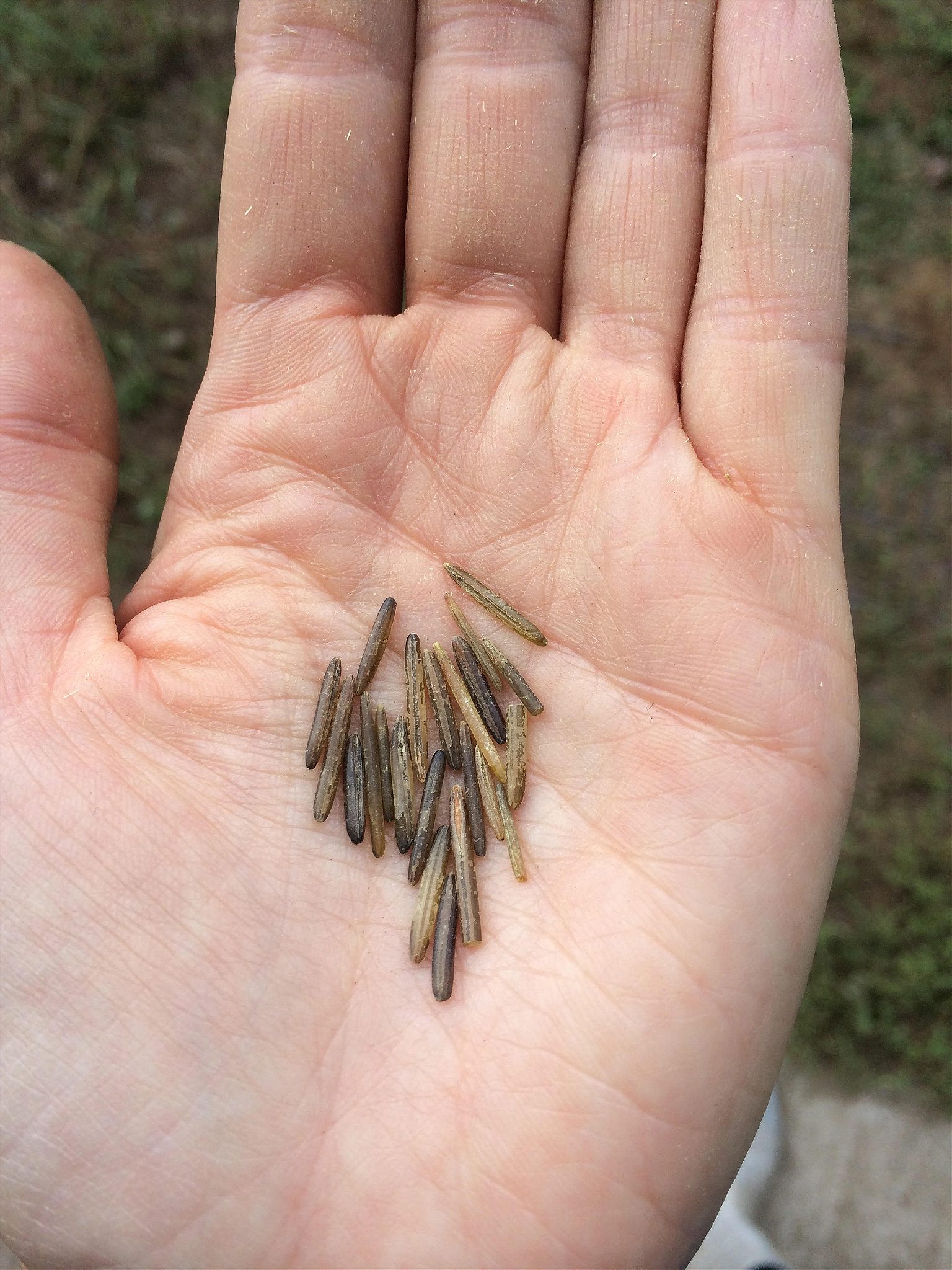In northern Minnesota, beds of wild rice long harvested by the Anishinaabeg people are slowly disappearing
Each year in autumn, the Anishinaabeg people take to the lakes of northern Minnesota to harvest wild rice, the only grain native to North America. They travel in pairs: one person to row and the other to gently knock the grains into the bed of the canoe with a long pole. This is how they’ve harvested wild rice for centuries. The grain is an integral part of the culture and economy of the Northwoods region, the wilderness that stretches from north-central Minnesota across the Great Lakes to Michigan.
For the past century, wild rice beds across the region have steadily diminished, forcing the state to conduct a comprehensive survey of waterways where wild rice grows to determine the threats to Minnesota’s state grain and how to protect it for future generations. There are several hazards: climate change; invasive species, including genetically modified wild rice cultivated in paddies; dams; and encroaching farmland. Yet the state’s focus has fallen on one culprit identified more than 70 years ago: sulfate. Although sulfate occurs naturally, mining, wastewater plants, and other industrial facilities discharge large amounts of the mineral into the waterways where wild rice stands thrive. The resulting decline in wild rice has pit Native American harvesters and environmentalists against big industry, with Minnesota’s pollution control agency stuck in the middle.
Even as far back as the 1930s, biologist John Moyle had established sulfate’s impact on wild rice. “No large stands of rice occur in water having sulfate content greater than 10 ppm (parts per million),” Moyle concluded after a decade of research. “And rice generally is absent from water with more than 50 ppm.”
Moyle’s work led the Minnesota Pollution Control Agency (MPCA) to adopt a standard of 10 mg of sulfate per liter of water in 1973, a standard that has rarely if ever been implemented in the last 40 years. The MPCA has given no one clear reason exactly why a standard that was on the books was never applied to industries applying for permits. Officials with the MPCA said it was a combination of things: They were focused on other water quality issues, like mercury and excess sediment; the data on wild rice was inadequate; and the regulations and statutes governing wild rice were a tangled mess. Native American groups claim the MPCA was coddling business and taking advantage of the muddled jurisdictions on land in and around reservations in order to let big industry do what they liked.

Regardless, only after a long decline that saw the number of licenses sold to rice harvesters fall from a peak of 16,000 in 1968 to less than 1,500 in 2006 did the state finally take decisive action to understand and protect wild rice. In 2008, Minnesota’s Department of Natural Resources (MDNR) surveyed wild rice beds and issued a report on the importance of wild rice, potential threats, and recommendation for the future.
“Nowhere has natural wild rice been more important, nor had a richer history, than in Minnesota,” the survey’s authors wrote. “No other native Minnesota plant approaches the level of cultural, ecological, and economic values embodied by this species.”
Following the survey, the MPCA was tasked with developing a new standard for sulfate levels in Minnesota’s wild rice water, based on a massive research effort initiated in 2011 to determine the exact mechanism whereby sulfate inhibits wild rice stands. Their preliminary analysis was released in March of this year, and the state legislature mandates a new standard be in place by January 2018.
The search for a new sulfate standard for Minnesota’s waterways puts wild rice in the middle of a discussion about how to reconcile Native fishing and hunting rights and the protection of northern Minnesota’s rivers, lakes, and forests with the economic needs of our modern society. The MPCA has met with criticism from Native tribes, environmental advocates, and also from mining and wastewater representatives. One side worries that the standards will only push the demise of wild rice back a few generations, while the other worries about the effect any new standard will have on the bottom line.
There is no easy answer, but with climate change already thinning out the hardwood forests of northern Minnesota and changing the biological makeup of the land, the decision on how to best protect wild rice may have wide-reaching and long-term effects.
Wild rice is a sacred grass
Wild rice is Anishinaabeg soul food. The Anishinaabeg, also known as the Chippewa or Ojibwe, use it as a staple like any other starch, as flour for breads, in soups with beans and meat, as stuffing for birds, and even chilled with cream for dessert. But it’s more than just an important food: wild rice is a sacred grass, the foretold grain, this tribe’s manna.
The Anishinaabeg didn’t always live around the Great Lakes region; they migrated here from the Atlantic coast centuries ago, after seven prophets came to them and urged the tribes to move west to avoid new peoples with new blood who would be arriving soon. According to legend, the prophets told them to stop when they found “food that grows on the water.” When they reached the lakes of Wisconsin, Minnesota, and Ontario, the Anishinaabeg found wild rice, which they call manoomin—the good berry—and they stayed.
The wild rice harvest formed the core Great Lakes life for generations, linking the many tribes together and lending its name to places and clans. When European settlers arrived, everything changed for the Anishinaabeg. Conflict and trade became the new pillars of Great Lakes life, culminating in a series of treaties signed between the Anishinaabeg and the U.S. government between 1837 and 1867. The treaties ceded millions of acres of the Northwoods to the government, with the Native tribes retaining hunting and fishing rights to the land. The 1867 treaty created the 837,000 acre White Earth reservation in north central Minnesota, the main Anishinaabeg (Ojibwe) reservation. White Earth is the political and cultural heart of the Ojibwe nation, and its people and leaders have been outspoken critics of U.S. government policy and advocates of Native rights to land and resources.

“The Anishinaabeg of the upper Mississippi and western Great Lakes have for generations understood their connection to anishinaabe akiing (‘the land of the people’) in terms of the presence of this plant as a gift from the Creator,” wrote Erma Vizor in 2008, as tribal chairwoman of the White Earth Nation. “In the words of White Earth’s Tribal Historian, Andy Favorite, ‘Wild rice is part of our prophecy, our process of being human, our process of being Anishinaabe… we are here because of the wild rice. We are living a prophecy fulfilled.’”
Manoomin has been harvested for at least 2,000 years, researchers found, by the many clans and tribes that call the Great Lakes home—including the Anishinaabeg, Odawa, Potawatomi, Winnebago, Cree, and others. Wild rice is a central part of their origin myth, present at the most important ceremonies, and one of the sacred traditions that bind the Anishinaabeg clans into one people.
“For many people in Minnesota, wild rice is totally off the screen,” said Bob Shimek, director of the White Earth Land Recovery Project (WELRP). “They’re not harvesters, there is no cultural connection, no sense of belonging or even the right to protect. It’s the inverse for all these things for the Anishinaabeg. For us it’s just like turkey at Thanksgiving or any other foods served during holidays for the other faiths of the world. It symbolizes that connection, and makes real the connection, between where this food came from and our participation in the cycle that perpetuates the manoomin.”

In the 2008 report, MDNR officials concluded much the same: As Minnesotans grow more and more removed from their own natural habitats and the many plant and animal species that surround them, they lose a sense of ownership and responsibility. Protection is so often linked to a sense of value, and if people do not value wild rice, it’s hard to garner support for regulations that might limit recreational and economic use of the Northwoods region.
And yet wild rice presents a significant yearly boost for the harvesters, processors, and distributors who remain. Raw wild rice goes for roughly $2-$3 per pound; processed, it sells for as much as $10. Harvests vary from year to year—floods in 2012 washed out the rice beds and made that year’s harvest almost a complete loss—but a typical wild rice harvest is between five and 10 tons. Native harvesters make up the majority of the state’s ricers. (Native harvesters generally do not require DNR licenses, so although roughly 1,500 licenses are sold each year, the actual number of harvesters hovers around 4,000). The economic impact of a good rice year can mean a new car, an upgrade to a house, and sacks full of highly nutritious grain for a marginalized population already suffering under much higher poverty rates than the rest of the state.
Shannon Lotthammer is the director of the Environmental Analysis and Outcomes Division at the MPCA, and she gets excited talking about the intricate dance between iron, carbon, sulfate, and oxygen in the sticky mud of Minnesota’s waterways. Lotthammer was part of the team tasked with identifying the state’s wild rice beds and finding out what exactly happens when sulfate and wild rice mix.
It turns out that in the deep mud, an oxygen-depleted place filled with bacteria, sulfate is food. When bacteria break down sulfate, toxic sulfide is the byproduct. So it’s actually sulfide that harms the wild rice, and not sulfate. Bacteria will choose sulfate as a source of energy if there is a lack of carbon—their first choice. Furthermore, iron can bond with sulfide and render it harmless. MPCA researchers developed an equation that takes into account the levels of carbon, sulfate, and iron in sediment, which forms the backbone of the new proposed standard. In theory, if a lakebed has large amounts of carbon matter and larger amounts of iron, then it might be able to handle more sulfate discharge than a shoreline with less carbon and iron.

This type of complex analysis is worrying to many interested parties. Many would rather have a simple one-size fits all approach, be it the 10 mg per liter established in 1973, or a much higher one more friendly to business interests. The problem, Lotthammer argues, is that one size does not fit all. A single standard of 10mg per liter, for example, would underprotect some waterways and overprotect others.
Part of the challenge of implementing the old standard was the language used at the time. The 10 mg of sulfate was supposed to apply to “water used for production of wild rice… during periods when the rice may be susceptible to damage from high sulfate levels.” But what constitutes water used for production of wild rice and when exactly is rice susceptible to sulfate? No one knew about the sulfide connection until after research began in 2011, and defining what waters are used for the production of wild rice has brought up questions regarding streams feeding into lakes, the size of wild rice stands on a lake, varying harvest levels, and the relationship between water fowl and wild rice beds.
Going further, sulfate occurs naturally throughout Minnesota’s groundwater and the state uses primarily groundwater for its drinking water. The standard for sulfate levels in drinking water is 250 mg per liter; so just in terms of wastewater there is a significant amount of sulfate entering rivers and lakes every day. Sulfate is a salt, and desalination is a notoriously expensive and arduous process that creates its own waste, which also requires treatment. Spending money and resources on all of this takes resources away from treating other pollutants.
“It gets challenging very quickly,” Lotthammer said, “Given the nature of sulfate and sulfate treatment.”

But wild rice has emerged as the ecologically critical, endangered species forcing the MPCA to meet the challenge. There is no substitute plant that fits into the region’s niche ecologically: Wild rice provides structure to the shoreline, a habitat for fish, and a food source for migratory birds. It’s also North America’s only native grain and the only species which demands its own protective standard—usually a standard for levels of harmful pollutants applies to a community, or ecosystem, and not a single species.
“From the standpoint of ecological diversity and a change to the important ecological structure of these water bodies, losing wild rice would be a significant diminishment,” Lotthammer said. “We’re not saying the standard will apply to every single stand of wild rice, but we need to have enough to support wildlife and for humans to harvest, that is important and that is what we are trying to protect and preserve.”
The MPCA feels a standard based on the carbon-iron-sulfate equation and a threshold of 8,000 stems above water in lakes and 800 stems above water per mile of river makes the most sense. In the meantime, the old standard on the books has been effectively put on hold while the agency goes through the process of review before their recommendations go into effect as law in Minnesota. Not only is the 1973 standard as toothless as it has always been, but any facility applying for a permit to discharge sulfate is not required to spend money on any designs or plans to mitigate any harmful effects to the ecosystem.
The MPCA is in a position where they have new information regarding the sulfate standard, but cannot require new or renewed permits to comply. So instead of de-prioritizing permits or applying standards that are not yet enshrined in law or approved under the Clean Water Act, the agency is focusing their resources on meeting the January 2018 deadline for a new standard.
“In addition to the fundamental goal of protecting wild rice production, our goal throughout this standard evaluation and the coming rulemaking process is to have a standard that is grounded in up-to-date science, clear as to where and when it applies, and that can and will be implemented,” Lotthammer said. “The current situation is frustrating for everyone, not the least of which the MPCA, as we take our responsibility of protecting the environment and enhancing human health—and that includes wild rice—very seriously.”
Environmental protection is too often about kicking the can down the road
Up in the Northwoods, the first rice seeds are beginning to germinate in a thousand recently thawed lakes. They will emerge slowly over the summer and rise up into swaying stands until the grain ripens under the late August sun and the canoes take to the water, as they have for generations. By then, young geese with bellies filled with manoomin will be heading south for the first time. Someone will pull a fat autumn walleye out of the waters and cook it on a campfire under the northern moon.
This is the vision that had John Moyle out on the lakes in the 1930s studying sulfate and rice, the same vision that had Shannon Lotthammer out there last year doing the same thing: The Minnesota the Anishinaabeg fell for so long ago, and the one people are trying to preserve right now. It’s a noble struggle, and one everyone wants to get right.
“Environmental protection in this country is too often about kicking the can down the road, to the next generations, so we can profit now,” Shimek said. “We need to get America to understand that there are niches where something special is going on, and if we don’t step up now, there is a good possibility that 50 to 100 years down the road there won’t be any of these special places left to protect.”